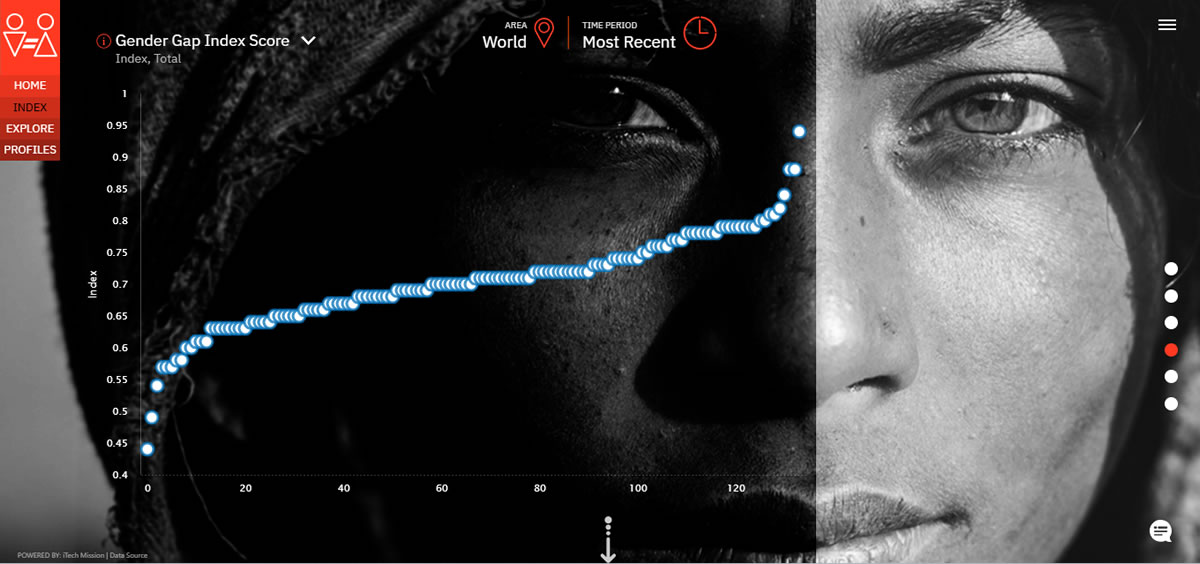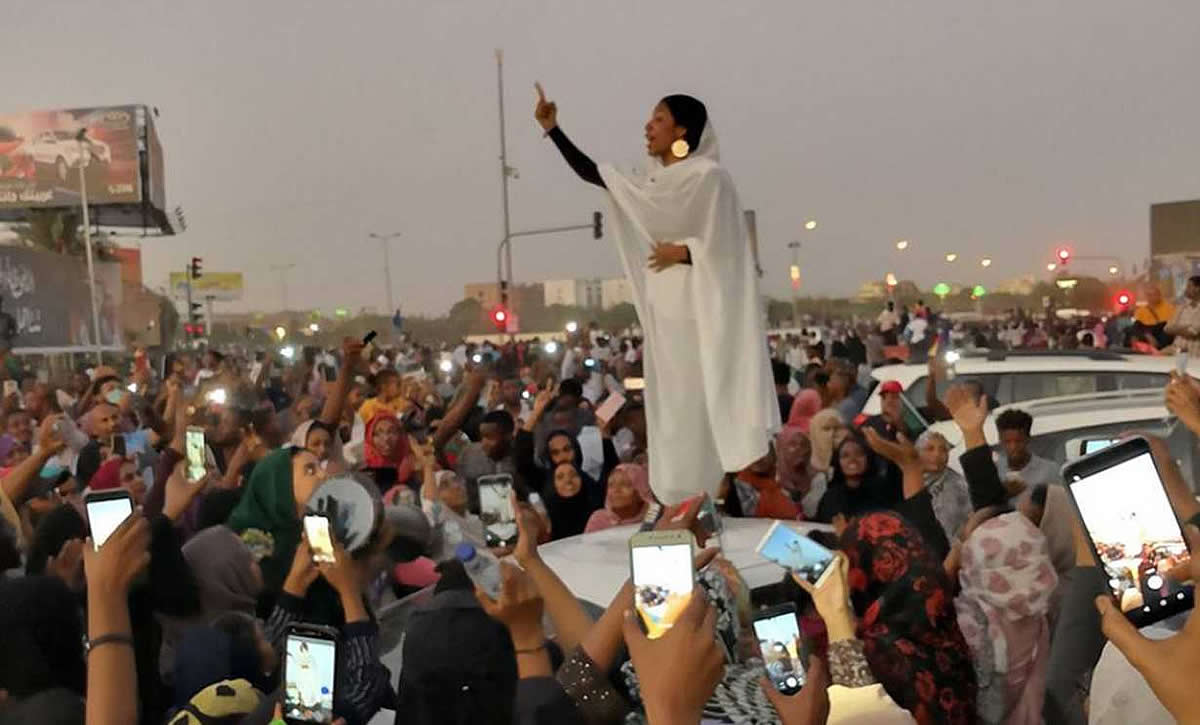Gender Gap Sudan

Sudan – iTech Mission (iTM)
The Gender Gap in Sudan: Challenges and Progress
Sudan faces significant gender disparities across multiple sectors. These gaps affect education, employment, health, and political participation. Sudan ranks low in gender equality according to the World Economic Forum’s Global Gender Gap Report. However, Sudanese women continue fighting for equality despite persistent challenges.

Kandake of the Sudanese Revolution (also known as Woman in White and Lady Liberty of the Sudanese Revolution; Arabic: كنداكة الثورة السودانية) is a photograph of Alaa Salah, a 22-year-old student, standing on top of a car, dressed in white and gold, and leading a crowd of demonstrators in chant during the Sudanese anti-government protests on 8 April 2019. The photograph, taken by activist Lana Haroun using a smartphone, gained world-wide media attention and went viral in April 2019, and was described by several media organizations as iconic, representing women’s participation in the revolution, who were dubbed the Kandakas.
Historical Context
Colonial Era Foundations
British colonial rule established many discriminatory practices. Colonial administrators limited women’s participation in public life. They reinforced traditional gender roles through legal frameworks. These policies created lasting institutional barriers.
Post-Independence Struggles
Independence in 1956 brought new opportunities for women’s rights. However, traditional attitudes persisted in many areas. Discriminatory laws historically constrained Sudanese women, impeding their decision-making abilities concerning marriage, education, and employment.
Progressive movements emerged during this period. Women’s organizations began advocating for equal rights. Their efforts laid groundwork for future advances.
Understanding the Gender Gap
Defining Gender Inequality
Gender gaps measure differences between men’s and women’s opportunities. These disparities appear in economic participation, educational access, and political representation. Sudan’s gender gaps reflect both historical discrimination and ongoing structural barriers.
Current Statistics
Sudanese women have less than a third of the legal rights men have in key economic dimensions. The Gender Parity Index in primary education was 0.95733 as of 2018. This indicates that there were 95.733% as many girls as boys enrolled in primary and secondary education. While this shows improvement from 0.94 in 2015 to 0.97 in 2017, there is still a gender gap in enrollment and completion rates.
Males have better employment opportunities than females regardless of age, location, or education level. These statistics reveal the scope of gender inequality in Sudan.
Key Organizations Fighting Gender Inequality
The Sudanese Women’s Union (1952)
The Sudanese Women’s Union (SWU) was created in 1952 during the struggle for independence from Britain. Fatima Talib, Khalida Zahir and Fatima Ahmed Ibrahim formed the executive committee.
The SWU became one of the biggest post-independence women’s rights organisations in Africa. It fought for voting rights, educational access, and workplace equality. The organization mobilized thousands of women nationwide.
Leadership Changes
Fatima Talib served as the first president of the Union. In 1956, Fatima Ahmed Ibrahim was elected president of the SWU. Khalida Zahir was elected president in 1958.
Each leader brought unique perspectives and strategies. Their combined efforts created sustainable change across Sudan.
Modern Women’s Organizations
Contemporary groups continue the SWU’s legacy. Organizations range from old historical left-wing groups to the Islamist General Federation of Sudanese Women. They represent diverse ideological orientations and social classes.
These organizations adapt to current challenges while maintaining core goals. They focus on economic empowerment, education, and political participation.
Influential Leaders and Activists
Fatima Ahmed Ibrahim (1933-2017)
Fatima Ahmed Ibrahim led Sudan’s women’s rights movement for decades. She combined political activism with grassroots organizing. Ibrahim connected women’s rights to broader social justice causes.
Her leadership during the 1964 revolution proved transformative. She mobilized women to participate in street protests. This participation helped secure women’s voting rights.
Contemporary Activists
Modern activists build upon Ibrahim’s foundation. They address new challenges while honoring historical achievements. Many work within civil society organizations and political parties.
These leaders focus on economic empowerment and legal reform. They also advocate for increased political representation.
Educational Gender Gaps
Primary Education Disparities
The Gender Parity Index in primary education in Sudan as of 2006 was 0.8. This means girls’ enrollment lagged significantly behind boys’. Rural areas show even larger gaps.
Cultural attitudes often prioritize boys’ education. Families with limited resources choose male children’s schooling. Economic pressures force girls to work instead of attending school.
Secondary and Higher Education
Gender gaps widen at higher educational levels. Fewer girls complete secondary education than boys. University enrollment also shows significant disparities.
However, recent trends show gradual improvement. More families recognize education’s importance for girls. Government initiatives also promote female education.
Adult Literacy
Adult literacy rates reveal historical educational neglect. Older women show particularly low literacy levels. Programs now target basic literacy and numeracy skills for women.
These programs address decades of educational exclusion. They provide second chances for adult learners. Community-based approaches prove most effective.
Economic Participation Gaps
Employment Disparities
Males, irrespective of their age, geographic location or level of education, have better opportunities finding employment than females. This systematic disadvantage affects all women regardless of qualifications.
Women face discrimination in hiring and promotion. They often work in informal sectors without protection. Pay gaps persist even for similar work.
Legal Barriers
Sudanese women have less than a third of the legal rights men have in key dimensions related to access to economic opportunities. These restrictions limit women’s economic independence.
Legal reforms remain essential for closing economic gaps. Women need equal rights to own property and start businesses. They also require protection from workplace discrimination.
Informal Economy
Many women work in informal sectors. They lack job security and benefits. These positions offer little advancement opportunity.
However, informal work provides crucial income for families. Women’s economic contributions often go unrecognized. Policy makers must address informal sector challenges.
Health and Social Disparities
Maternal Health
Sudan faces significant maternal health challenges. Rural women have limited access to healthcare. This affects both mothers and children’s wellbeing.
Traditional practices sometimes harm women’s health. Female genital mutilation remains widespread. Education campaigns work to change these practices.
Gender-Based Violence
Violence against women remains a serious problem. Sexual and gender-based violence occurred throughout Darfur. Conflict situations increase women’s vulnerability.
The escalating conflict has disproportionate impacts for Sudanese women and girls, including the 5.8 million who are internally displaced. Recent conflicts have worsened these conditions significantly.
Support services for survivors remain inadequate. Legal protections need strengthening. Community awareness campaigns help address root causes.
Political Representation Gaps
Historical Exclusion
Women faced systematic exclusion from politics historically. Traditional societies limited their public participation. Colonial and post-colonial governments maintained these restrictions.
The 1964 voting rights victory marked a turning point. However, cultural barriers continued limiting women’s political involvement.
Current Representation
Women remain underrepresented in government positions. They hold few ministerial or parliamentary seats. Local government shows similar patterns.
Political parties often marginalize women’s voices. They rarely select female candidates for winnable positions. This perpetuates male dominance in politics.
Recent Progress
The 2019 revolution brought new opportunities. Women played crucial roles in overthrowing Omar al-Bashir. Their participation demonstrated political engagement capabilities.
Transitional arrangements included women in key positions. However, recent military coups threaten these gains. Political instability hampers sustained progress.
Impact of Conflict and Crisis
Darfur Crisis
The Darfur conflict severely affected women. Sexual and gender-based violence occurred throughout Darfur. Women faced targeted attacks and displacement.
Non-governmental organizations worked to stop this gender violence. However, the government expelled thirteen NGOs that resulted in the closure of most services.
Recent Conflicts
Current conflicts continue harming women disproportionately. The humanitarian crisis has catastrophic impact for women and girls, with two-fold increase of gender-based violence.
Displacement disrupts education and economic opportunities. Women bear additional responsibilities for family survival. International support remains crucial for addressing these challenges.
International Efforts and Support
UN Women Initiatives
UN Women works extensively in Sudan. Closing gender data gaps is essential for achieving gender-related SDG commitments in Sudan. They support data collection and policy development.
Programs focus on women’s economic empowerment. They also address violence prevention and response. Educational initiatives receive significant attention.
World Bank Programs
The World Bank supports gender equality initiatives. They provide funding for women’s economic participation. Educational programs receive particular emphasis.
Research and data collection help identify priority areas. Evidence-based approaches improve program effectiveness.
European Union Projects
The EU supports gender equality through education and community engagement programs. These initiatives target rural communities particularly.
Community-based approaches prove most sustainable. They build local capacity for continued progress.
Data Challenges and Monitoring
Information Gaps
Many areas such as gender and poverty, physical and sexual harassment, women’s access to assets (including land), and gender and the environment lack comparable methodologies for regular monitoring.
Limited data hampers effective policy making. Regular monitoring systems need strengthening. Standardized methodologies would improve comparability.
Measurement Difficulties
Gender gaps prove difficult to measure accurately. Cultural factors affect data collection. Rural areas present particular challenges.
Investment in data systems remains essential. Reliable information guides effective interventions. Regular surveys track progress over time.
Success Stories and Progress
Educational Advances
Recent years show gradual educational progress. More girls complete primary school than previously. Secondary enrollment also improves slowly.
Community awareness campaigns prove effective. They change attitudes about girls’ education. Economic arguments resonate with families.
Economic Empowerment
Women’s economic participation gradually increases. Microfinance programs support female entrepreneurs. Skills training opens new opportunities.
Technology creates new possibilities for women. Mobile banking increases financial inclusion. Online platforms connect women to markets.
Political Participation
Women’s political engagement continues growing. The 2019 revolution demonstrated their capabilities. Civil society organizations strengthen their voices.
Young women show particular political interest. They organize effectively using modern communication tools. Their engagement promises future progress.
Looking Forward
The gender gap in Sudan requires sustained attention and coordinated action. Current challenges are significant, but progress remains possible. Historical achievements demonstrate women’s determination and capability.
Future success depends on multiple factors. Legal reforms must guarantee equal rights and opportunities. Educational investments need prioritizing, particularly for girls’ schooling. Economic policies should address women’s specific needs and barriers.
Political stability remains essential for sustained progress. Conflict and instability disproportionately harm women. Peaceful transitions create opportunities for advancing gender equality.
International support continues playing a crucial role. Technical assistance and funding help implement effective programs. Knowledge sharing accelerates progress across different sectors.
Data collection and monitoring require strengthening. Better information guides more effective interventions. Regular assessment tracks progress and identifies remaining challenges.
Civil society organizations need continued support. They provide essential services and advocacy. Their grassroots connections ensure programs reach intended beneficiaries.
Young women represent Sudan’s future. Their education and empowerment will determine long-term progress. Investment in their development pays dividends for entire society.
The path forward requires patience and persistence. Gender gaps developed over generations. Closing them takes sustained commitment from all stakeholders. However, Sudan’s women have shown remarkable resilience throughout history. Their continued efforts, supported by progressive policies and international cooperation, will gradually eliminate remaining barriers.
Success requires recognizing women’s contributions to society. Their economic participation strengthens families and communities. Political involvement improves governance and decision-making. Educational advancement benefits current and future generations.
Sudan’s journey toward gender equality continues. Each step forward honors previous generations’ sacrifices. It also creates better opportunities for coming generations. The struggle for equality remains challenging, but the destination promises a more just and prosperous society for all Sudanese people.
Sources and References
- “Sudan Women: Rights, Empowerment, Challenges & Contributions” – SAPA-USA, January 2024
sapa-usa.org/sudan-women - “Women in Sudan” – Wikipedia, March 2025
wikipedia.org/Gender_inequality_in_Sudan - “Sudan’s women and youth are severely economically deprived” – World Bank Blog
blogs.worldbank.org/sudans-women-and-youth - “Sudanese Women’s Union” – Wikipedia, February 2025
en.wikipedia.org/wiki/Sudanese_Women’s_Union - “Country Fact Sheet” – UN Women Data Hub
data.unwomen.org/country/sudan - “Sudan humanitarian crisis has catastrophic impact for women and girls” – UN Women, September 2024
unwomen.org/sudan-humanitarian-crisis - “Supporting Gender Equality in Sudan Educational System” – UNESCO Core Data Portal
core.unesco.org/en/project/3210122021 - “The Archives of the Women’s Movement in Sudan, 1940-2010” – Modern Endangered Archives Program
meap.library.ucla.edu/womens-movement-in-sudan - “Gender inequalities: fighting for inclusivity with education and community engagement in Sudan” – Capacity4dev
capacity4dev.europa.eu/gender-inequalities-sudan

